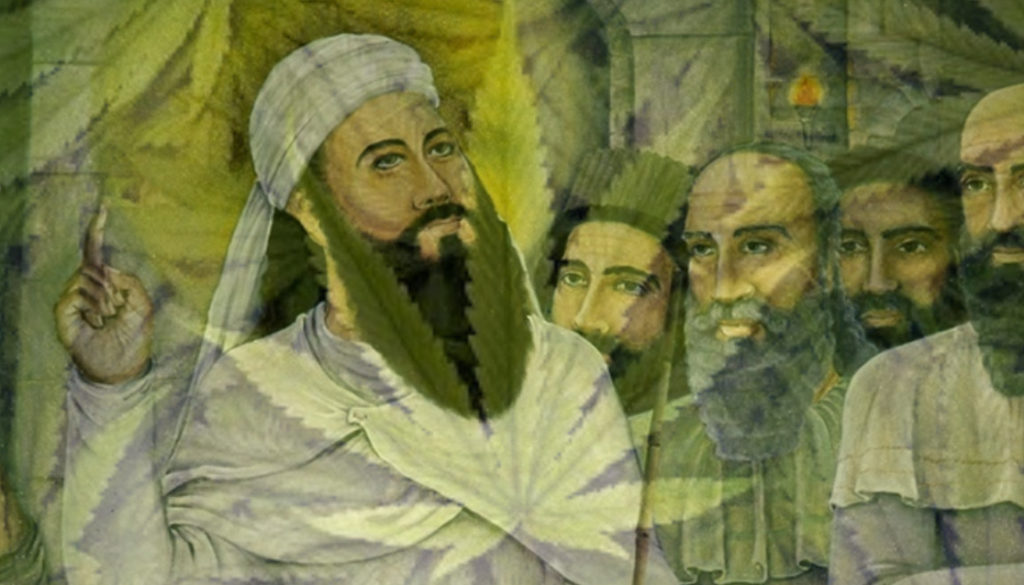The ancient religion of Zoroastrianism is still a practiced faith today, and its influence on the cosmologies and beliefs of Judaism, Christianity and Islam has long been noted by religious scholars. However a topic less discussed are ancient Zoroastrian references to the shamanic use of potent cannabis infusions. Was the Zoroastrian religion a cannabis revelation?
The Magi appear to have been acquainted with the narcotic properties of opium, hemp, and other substances; and by long fasts, and the administration of these opiates, induced a state of trance or ecstasy, favourable to the conception of visions, and the stimulation of accesses of inspiration. They were accustomed to propitiate the spirits with loud songs and chants, either of triumph or woe, entreaty or indignation.
-J. Maxwell, Dwellers on the Threshold: Or, Magic and Magicians, (1865)
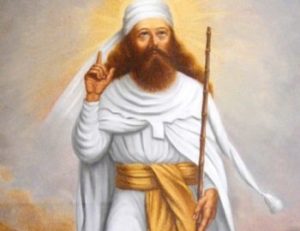
Zoroaster
The name Magi, from where we get terms like, ‘magic’ and ‘magician’ is generally associated with ancient Zoroastrianism, an ancient Persian religion that may have originated as early as 4,000 years ago. Arguably the world’s first monotheistic faith, it’s one of the oldest religions still in existence. It was founded by the Prophet Zoroaster, (or Zarathustra), who is thought to have lived and died sometime between 1500 BC – 1000 BC (aged 77). A monotheistic prophet like Moses, he changed the polytheistic worship of Mazdaism into the montheistic worship of the one god Ahura Mazda.
The Zoroastriasn texts refer to a substance variously known as bhanga, or in Pahvlavi as mang. Bhanga is still used in Persia to identify cannabis and the related Indian term bhang is still used for cannabis as well.
In reference to Zoroastrian expeditions into the world of the afterlife, Shaul Shaked noted that “The preparation of this journey was done… by administering to the officiant a dose of mang (hemp), mixed with wine” (Shaked, 1999). “Zoroaster is commonly said to have spiked the haoma with mang, which was probably hashish. It would have prolonged the intoxication and further stimulated the imagination of the drugged man. Of such are the wonders of Heaven” (Oliver, 1994). In the Zoroastrian tale “…the Artak Viraz Namak… Hell, Purgatory, and Heaven, the rewards bestowed on the good, and the punishment awaiting the sinner are here described in a vision induced by hashish” (Campbell, 2000). Referring to this same account, van Baaren and Hartman also noted the hero “imbibes an intoxicant composed of wine and hashish and after this his body sleeps for seven days and nights while his soul undertakes the journey” (van Baaren & Hartman,1980). 19th century author James Francis Katherinus Hewitt also refers to the “enlightening prophet drug Bangha (Cannabis Indica), the Hashish by which the Zoroastrian priests were inspired” (Hewitt, 1901) This was also the view of Nyberg (1938), whose work we have discussed, and the German Iranist, Geo Widengren (1965), as well as more recent researchers.
The use of bang/mang in the Zoroastrian period was strictly prohibited from anyone but the most elite members of that society. The secrecy surrounding the use of bang/mang is likely largely responsible for much of the confusion surrounding the terms mang and bang. In ‘Quests and Visionary Journeys in Sassanian Iran’, Shaul Shaked notes that the use of mang (which he saw as hemp) for visionary quests, “was not a way open to all”:
It was confined to select individuals, who would have regarded themselves as representative of the community, and who would then reveal to the others what they had been privileged to witness. Even for those people this was not a trivial experience that could be undertaken casually or easily repeated. Such journeys were rare occasions, surrounded by grave risks. The danger lay in the very fact that this was the path trodden by the dead, and would have to be brought back to life. Certain encounters along the way may put the power of endurance of the traveler to the test.(Shaked, et al., 1999)
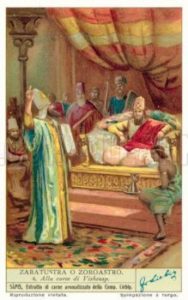
Zoroaster addresses King Vistaspa
The story has it that Zoroaster wandered the countryside for ten years without winning over the people to his new religious concepts. It was not until he met King Vishtaspa, who converted to Zoroaster’s religion after drinking a cup of mang that the Iranian prophet’s beliefs began to take hold on a wide scale. “Vishtaspa used hemp (bhang) to obtain ecstasy: while his body lay asleep, his soul traveled to paradise” (Eliade 1978). Vishtaspa’s shamanic journey is recorded in Denkird 7.4.83-6 and Pahlavi Rivayat 48.27-32. In the ninth century text the Denkird which was derived from a lost Avestan source, when Vishtaspa drank bhang “he became stard (unconscious) immediately, and they led his soul to paradise and showed him the value of accepting the Religion”:
To enlighten Vishtasp (and teach him)… and that he would attain a high post, permanent power, riches and food, Ohrmazd the Creator sent at the same time to the house of Vishtasp the yazat [a lesser divine being]Neryosang with a message urging… Arthavist to give to drink to Vishtasp the lightened drink that would grant the eye of whomever took it a glimpse at the spiritual world… And speak to Arthavist: ‘Lord Arthavist! Take the nice plate, the nicest of all that have been made… to take, from us, Hom [Haoma] and mang… (Denkird 7.4.84-86)
Gherardo Gnoli recorded: “bang was… an ingredient of the ‘illuminating drink’… that allowed Wištāsp to see… the ‘great mystery.’ This mang ī wištāspān (Pahlavi Vd. 15.14…) was mixed with hōm (Dēnkard 7.4.85) or wine (Pahlavi Rivayat 47.27). It was an integral part of the ecstatic practice aimed at opening the ‘eye of the soul’ (gyān čašm….)” (Gnoli, 1979). As Widengren explained:
Hemp and wine or hemp and haoma were mixed in the cup that was passed to Vistaspa….. it is said that Neryosang was sent forth to let Vistaspa drink ‘the eye of the soul’ with the view up above to the forms of existence of the heavenly beings, the illuminating potion thanks to which Vistaspa saw the great lucky splendour and mystery’. The typical expression gyan casm, ‘eye of the soul’, causes problems here. One could be tempted to replace this expression with ‘source of life’, and this in actual fact is how it was translated, which in a pure formal philological sense is completely possible. However the expression can be explained via two points in the Denkart, where, in regards to the enlightenment, it is stated that it is of two types: on the one hand it consists of a view with the eye of the body, tan casm, on the other hand it is a view with the eye of the soul, gyan casm, which is defined as ‘the opening of the eye of the soul to obtain knowledge’.‘The eye of the soul’ means introspection. The visionary sight is conveyed to Kavi Vistaspa using a haoma potion mixed with hemp. With this his soul can repair to Garodman, [Paradise] to view the heavenly existence. (Widengren, 1965)
A similar reference to the “eye” is found in the Indian Aitareya Brahmanam, “When.. the Adhvaryu hands over … the Soma cup to drink… to the Hotar, he receives it with the… mantra… (By the words): ‘This is a good which has knowledge; here is a good which has knowledge; in me is a good which has knowledge; ruler of the eye, protect my eye’ the Hotar drinks Soma from the Maitravaruna graha. (Then he repeats): ‘The eye with the mind is called hither.’” Martin Haug in his translation of this passage, noted “This formula resembles very much one of the most sacred prayers of the Parsis… which is particularly repeated when the Zotar priest (the Hotar of the Brahmans) is drinking the Homa (Soma) juice…” (Haug, 1863). In relation, in India the drinking of bhang by devotees is still believed to open up the “eye” of Shiva, i.e the “third-eye.”
Although references to the use of mang are much more clear cut and straight forward in the above accounts, the identification of Zoroaster’s use seems to be quite veiled. Hellholm and his co-authors make an important point in their statement that “According to the Bahman Yast, Zoroaster receives from Ahura Mazda the ‘wisdom of omniscience’” which appears to be closely related to drinking the cup of ecstasy: (Hellholm, et al., 1989) A situation on which a number of Iranists have commented. “The visionary receives the divine quality of omniscience… which is thought to be transmitted in liquid form, as told in Bahman Yasht” (Johnston, 2004).
And he (Ahura Mazda) put the wisdom of omniscience in the form of water in the hand of Zoroaster and said: “Drink”. And Zoroaster drank from it and he intermingled the wisdom of omniscience with Zoroaster. Seven days and seven nights Zoroaster was in the wisdom of Ahura Mazda. (Bahman Yast, 11.5-6)
As the authors of The Encyclopedia of Apocalypticism have noted of this passage, “The expression ‘in the form of water’ in the Bahman Yast to denote the drink Zoroaster consumed before his vision does not mean that it was water but only that it was liquid” (McGinn, et al., 2000). As we shall see, the drinking of the “cup of omniscience” by Zoroaster clearly resulted in a identical shamanic trip as that attributed to the drinkers of bhanga/mang in the Zoroastrian tradition:
After having consumed the “wisdom of omniscience,” Zoroaster sees the seven world continents and he is able to distinguish the finest details of humans, cattle, and plants. This is best explained on the assumption of a movement in space. In fact, we find a reference to an otherworldly journey undertaken by Zoroaster in a short citation from the sacred tradition preserved in the Denkard. Ohrmazd and the beneficient immortals address Zoroaster with the following words “You have come to paradise (garodman); now you know the actions that are done in the corporeal world and those that will be done, even in secret” (Dk IX,28:2). (McGinn, et al., 2003)
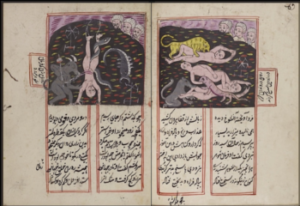
A page book from Arda Viraf’s trip from the after life
As noted above, Hellholm and his co-authors relate that the respected Iranist Geo Widengren, in his German language edition Die Religionen Irans (1965) believed that mention of mang was suppressed in the above accounts by later Zoroastrian religious writers, which would explain a lot of the confusion on the matter. A statement which left this researcher with the task of locating a copy of Widengren’s German language book Die Religionen Irans, and then acquiring translations of the relevant passages, some of which are reproduced below:
…[In] the Phalavi-apocalypse Bahman Yast…it is recounted – and we are moving here within a sphere of Avestan traditions – that Zarathustra assimilated the so called ‘rationality of omniscience’ by means of drinking water. Moreover it is recounted that, in doing this, the ‘rationality of omniscience’ was mixed with Zarathustra and this remained for seven days and nights in the reason of Ahura Mazda.
The most important thing about this description is that Zarathustra, in accordance with an established Avestan tradition, adopted an intoxication technique, to put himself in to a trance, during which he lies in deep sleep for seven days and nights. In Pahlavi at this point, the term for this deep sleep is xvamn; this is a ‘modern’ development of the Avestan word xvafna. It may therefore be assumed that the original Avestan tradition even used the term xvafna here. (Widengren 1965)
This state of xvafna was the core of both the Haoma and the mang experience. As Eliade explained, “…haoma is rich in xverenah, the sacred fluid, at once igneous, luminous and spermatic. Ahura Mazda is preeminently the possessor of xvarenah, but this ‘flame’ also springs from the forehead of Mithra and like a solar light emanates from the heads of sovereigns.” (Eliade, 1978). Referring to Zoroaster’s ingestion of the “cup of omniscience” Widengren wrote that in “a trance similar to that of the deep sleep, xvafna> xvamn, Zarathustra experienced his visions and heard the divine words of Ahura Mazda. It was probably also customary in the eldest congregations to induce this trance with a narcotic potion. This technique of intoxication presumably has Indo-Iranian ancestry, because it is documented in India as well.” (Widengren, 1965)
…[T]he tradition preserved in the Bahman Yt. does not mention the hemp potion as a physical ecstatic substance but it obviously concerns a potion, which Zarathustra partook of. It is possible that the later Pahlavi tradition thus blurred the original character of the potion, that it only states pat ap-karp…frac xvart – ‘in the form of water…he swallowed it’. Behind this transition from wine and hemp in AVN II 29 ff. to water in the Bahman Yt., one can well assume various tendencies of the Sassanids era….
….Now this description in Bahman Yast is however consistent in some respects with two other visionary narratives. One account is found in the Pahlavi Rivayats to Datastan i Denik, where it is told, how Zarathustra’s guardian, Kavi Vistaspa, obtains wine mixed with a narcotic [mang] from the messenger of the gods, Neryosang. Vistaspa immediately becomes unconscious and his soul is escorted to Garodman, the paradise.
This account bases itself meanwhile on an older version which we find in the Denkart. This Denkart text can be proved as an adaptation of a missing Avestan original due to the exegetical glosses, the quotes from the Avesta as well as the precious terminology. This original version shows several discrepancies: firstly the cup, which Vistaspa is passed, contains in this case hom ut mang, being haoma and hemp. (Widengren, 1965)
Widengren felt that based on this similar Avestan account of Vistaspa drinking Haoma mixed with hemp, and achieving a similar mystical experience to that of Zoroaster in the Bahaman Yast, the account of Zoroaster drinking water in the Bahman Yast, was based on an earlier Avestan tradition which involved the partaking of mang and later accounts were edited during the Sassanian period to hide this fact.
The Avestan and the Pahlavian references to Vistaspa drinking mang are pivotal in identifying Zoroaster’s own use of hemp as described in the ‘censored’ account recorded in the Bahman Yast.
…[W]e have to realize that the previously quoted Pahlavi text Bahma Yt, where Zarathustra’s ecstasy with his visionary experiences is described, bases itself on Avestan material, and in actual fact predominantly on the missing Stutkar Nask. It can therefore be subject to no doubt that the Avestan tradition also knew Zarathustra as a genuine ecstatic. (Widengren,1965)
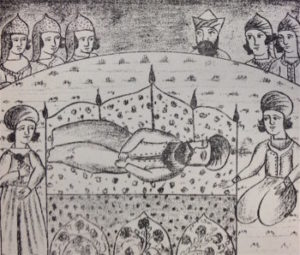
Arda Viraf laid out in a state of revelation
Accounts of Zoroaster’s shamanic flights are recorded in: Bahman Yasht 4.1-66, 5.1-10, 6.1-13, 7.1-39, 8.1-8, 9.1-8; Bundahishn 34.4-5; Denkard 8.8.22-59, 9.6, 10.11, 14.13. The suggestion that there was a connection between the mang and Haoma consumed by Vishtasp and the ‘water’ by Zoroaster has been noted by a variety of scholars. “Since sauma [mixed with mang]was the means by which Ohrmazd brought such vision to Zoroaster’s champion, Wishtasp, [Vistaspa] there is no reason to doubt that sauma [and mang]would also have been the means whereby Zoroaster (who as a zaotar consumed sauma in Yasna rites) also saw into menog existence [spiritual realm]and drew from it his knowledge of Ohrmazd and his revelation” (Flattery and Schwartz, 1989).
Ancient texts such as the Avesta provide evidence hemp was used in the Iranian world… to produce ecstatic states of mind. Zarathustra himself used this technique to nourish his mystique. In this he was imitating his protector, King Vishtasp, who received from the gods the cup with narcotic ingredients, “haoma and hemp.” Thanks to this “illuminating beverage” the possessed could “open the eye of the soul to obtain knowledge”—in other words, he experienced hallucinations and an intoxication that was certainly real, though considered as magico-religious. The king thought he was in this way escaping his body and sending his soul to travel in paradise. But the descriptions of the place or state of mind in question as being full of “illumination” are typical of the visions experienced by the consumer of hashish, along with a sleep like trance which obliges him to lie down. (Charriere, 1979)
However, it would seem after the institution of the Moslem period, when Zoroastrians were either forced out of Persia or forced to convert to Islam, the ritual use of cannabis in the religion declined and eventually seems to have gone underground. Although there is evidence that some use was still in play during the reign of the Sassanian King Khusraw Parvēz (57—628) and in “Azerbaijan, a former centre of the Zoroastrian religion and homeland of the cannabis- using Scythians, medieval manuscripts also record the use of wine infused with a mixture of cannabis, opium and henbane” (Dannaway, Piper & Webster, 2007). It is generally viewed that through these channels the use of cannabis was adopted by the more mystical branches of Islam. From what I have seen in the modern day, any mention of the religions ancient cannabis use to practicing mainstream Zoroastrians is met with disbelief and disdain.
The title, Magi, has been used for over 2,500 years in reference to Zoroastrianism. In the Hellenic period, when the Greeks were assimilating so much of other cultures traditions, whether accurately or not, the mysterious rites of Zoroastrians, became associated with everything from astrology, to necromancy, and the term ‘magi’ began its transition to becoming our modern words ‘magic’, and the practitioners of this, ‘magicians’. This association between ‘magic’ and occult rites and practices, was particularly revitalized in the Medieval period, and then forward, where Zoroaster was often considered the creator of magic. As Encyclopedia Iranica has noted:
Most prominent European scholars of magic of the early modern period devoted at least one brief passage to the supposed inventor of that discipline. Here, it may suffice to mention the names of authors such as Heinrich Cornelius Agrippa of Nettesheim (1486-1535), Giordano Bruno (1548-1600), Giambattista Della Porta (ca. 1535-1615), Jean Bodin (1530-96), Gabriel Naudé (1600-53), and Eliphas Lévi (1810-75). Contrary to the authors mentioned in the previous section, most of these authors… were in favor of a ‘pure’, or ‘natural’, version of magic that was carefully distinguished from its ‘demonic’ branch. Correspondingly, Zoroaster came to be regarded as a wise man, who would know about the secrets of nature and heaven. (Stausberg, 2005)
Zoroaster also appears frequently in the writings of later occultists, such as Blavatsky, Paschal Beverly Randolph, Crowley, and others. A number of times in his writings, Crowley borrowed a phrase from The Chaldæan Oracles of Zoroaster, “The girders of the Soul, which give her breathing, are easy to be unloosed” (Westcott, 1895) in reference to the effects of cannabis resin; “Perhaps hashish is the drug which ‘loosens the girders of the soul’.’’ (Crowley, 1909).*
It should also be noted that the voyages of these Zoroastrian psychonauts, may have influenced both Jewish and Christian cosmologies, with their voyages to Heaven and Hell, as well as tales of an Apocalyptic like end times.

